Strafe Background
Aspen, Colorado based, founded by American Skimo royalty—Pete and Jon Gaston—Strafe came to fruition in 2010. Despite their skimo racing background, the only one-piece suit you’ll see in Strafe’s current lineup is the Sickbird 3L Shell suit. News flash: the skimo influence isn’t at the forefront here.
Their premier touring kit, the Cham, has been through several fabrics and iterations over the years. The Cham kit began with the excellent Polartec Neoshell, then moved to a proprietary fabric, and is now settling with Schoeller Aerobrane. The common threads through each iteration prioritize breathability over absolute waterproofness, a baggier “freeride” fit, and minimalist designs to keep things lightweight. We tested the current lineup throughout winter 2022/2023.
Design Highlights
With its latest update about a year ago, the silhouettes of the Cham kit got a major upgrade. I had some experience with the previous pants, and while the fabric was excellent, the fit wasn’t my favorite. I hadn’t used the jacket, but the new anorak style is certainly on trend and fits the bill as far as lightweight.
Starting with the fabric, the Schoeller Aerobrane is excellent. The Schoeller name gets most people thinking of soft shells, which the brand is famous for. With Aerobrane, they use an electrospun PU membrane (think TNF Futurelight or Polartec Neoshell) paired with exceptionally soft and pliable face fabrics and backers to make the softest, stretchiest, most breathable 3-layer laminate I have ever used.
Let’s begin with the jackets. The line has expanded to two jacket options. First is a simple and lightweight anorak/pullover. There isn’t much to say about the pullover, which is the point. There’s a half-length coil zip, single chest pocket, velcro cuffs, non-adjustable but helmet-compatible hood, and cinchable hem. The feature set closely mirrors the Arc’teryx Alpha SL, but the fabric couldn’t be more different. Where the Alpha SL is my go-to rain jacket in the summer, I wouldn’t dream of walking uphill wearing it in most contexts. In contrast, I wore the Cham walking uphill with some regularity last winter.
Next, we have the full zip jacket, adding more standard features and weight (130g more than the pullover). This piece uses a full-length, molded tooth zipper, adding several pockets and adjustments relative to the pullover. It includes large dual chest pockets, an internal drop pocket and zip pocket, and a pass pocket on the sleeve.
Perhaps my favorite piece of the kit is the low-bib style pants. With an updated fit and adding a low stretchy bib and suspenders to the Cham pants, my favorite ski pants became even better. The bib material is light and stretchy and adds a small pocket to the kidney area. Hip pockets are on both sides; the right has an “electronics sleeve” and a clip-in point for a tether. The vents are updated to sit a bit more on the side of your thigh, call it 4 o’clock, which fixes a previous complaint of the bottom of the zip poking the back of my knee. The vents also have zipper sliders on top and bottom, so you can open them from either direction—depending on how you choose to vent. The cuffs are simple, with a large crampon/edge protection patch, a drawcord on the main cuff, and a softshell powder cuff to round things out. There are no zippers to fuss with, and the soft shell gaiter makes more sense to me than a PU-coated fabric that will eventually peel and flake. The fit is updated to be a bit more snug, generally, compared to previous models—this means I sized up to a large, compared to a medium in the previous version. The leg width feels more consistent, and the bibs mean the waist can be comfortably loose without worrying about falling—an issue I had with my old medium Cham pants.
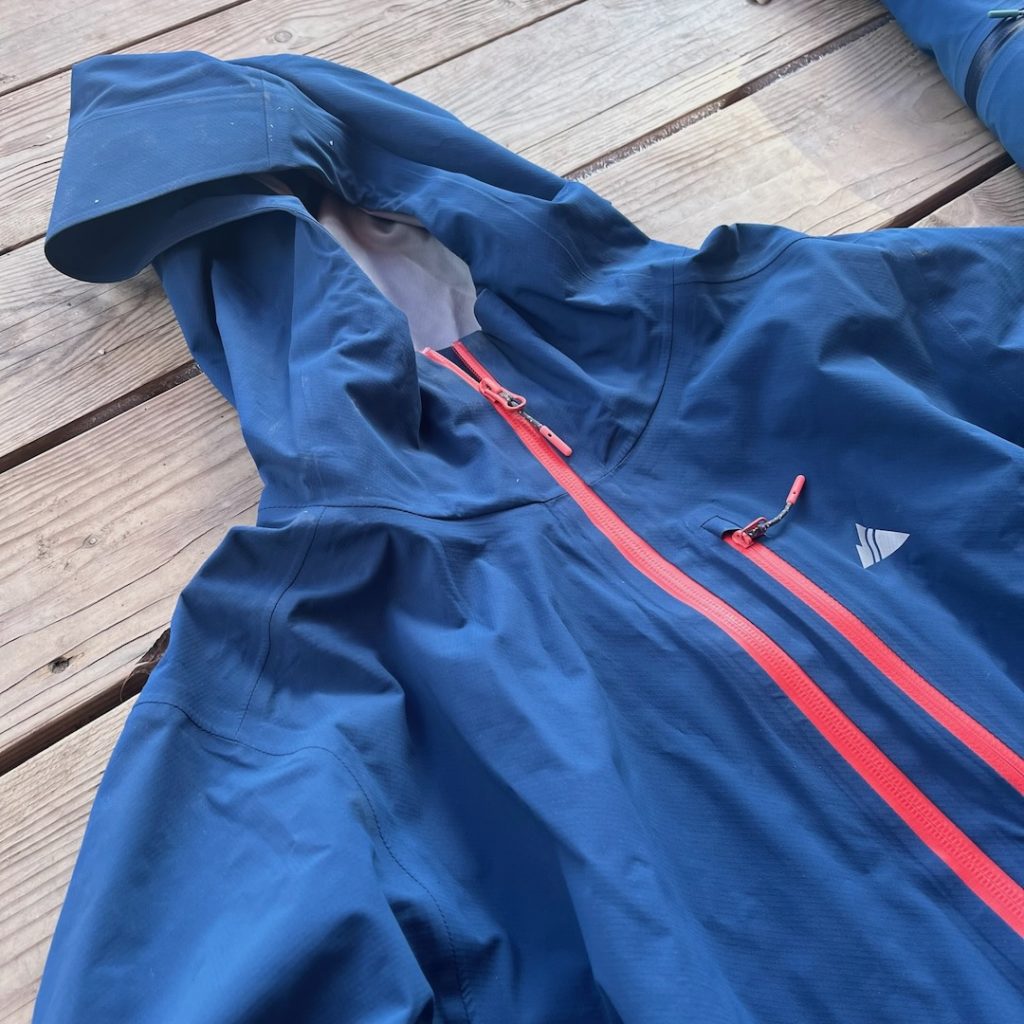
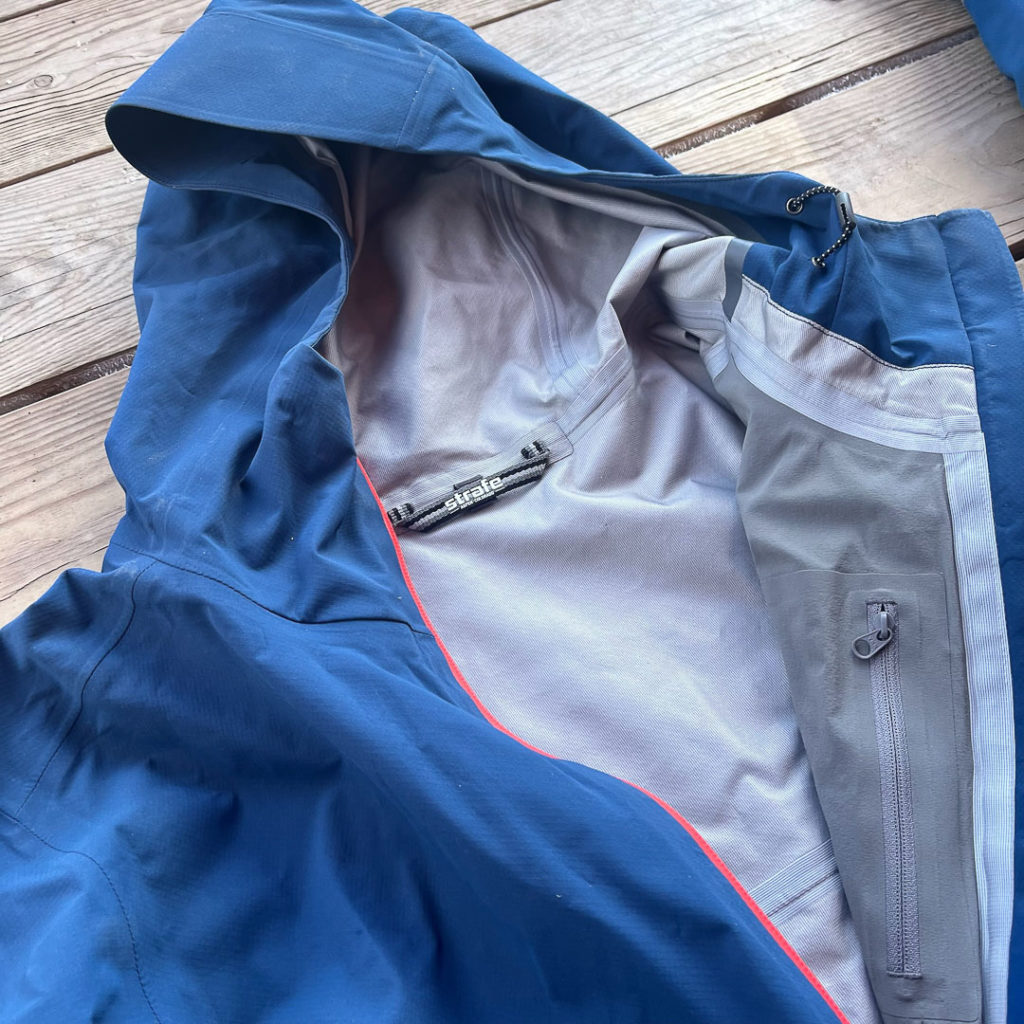
Field Testing
Pullover Jacket
As stated above, I often wore this jacket while walking uphill at a decent clip last winter. I think most readers will have gathered by now I am not some masochistic freerider that starts and finishes every touring day in a full Gore-Tex sweatsuit. With a bit of a breeze and perhaps some precip in the mix, I could walk and stay relatively dry.
The pullover/anorak silhouette is okay—I appreciate the minimalist approach, but often wonder if the additional grams for a full zip on an otherwise minimal jacket would be a welcome compromise. I wish the Cham were a bit longer in the torso. I am becoming more biased toward a below-the-hip cut on a hardshell jacket, but even an additional 2″ would benefit the Cham. I don’t mind the minimal features or lack of pockets; I have plenty of pockets in my pants, midlayer, or pack to make a single chest pocket feel like plenty.
For better or worse, the Cham is not a good layer for adding warmth. It is only breathable enough to block light winds and doesn’t really turn into a sauna like one might find with a less breathable jacket at moderate output. This permeability has obvious upsides regarding breathability and overall comfort, but it takes a slightly warmer layering system than something like a GoreTex Pro shell. I often wore a base layer and maybe fleece, then the Cham on or off on the way up, and added a synthetic parka like the Arc’Teryx Nuclei for the coldest parts of the day or longer breaks.
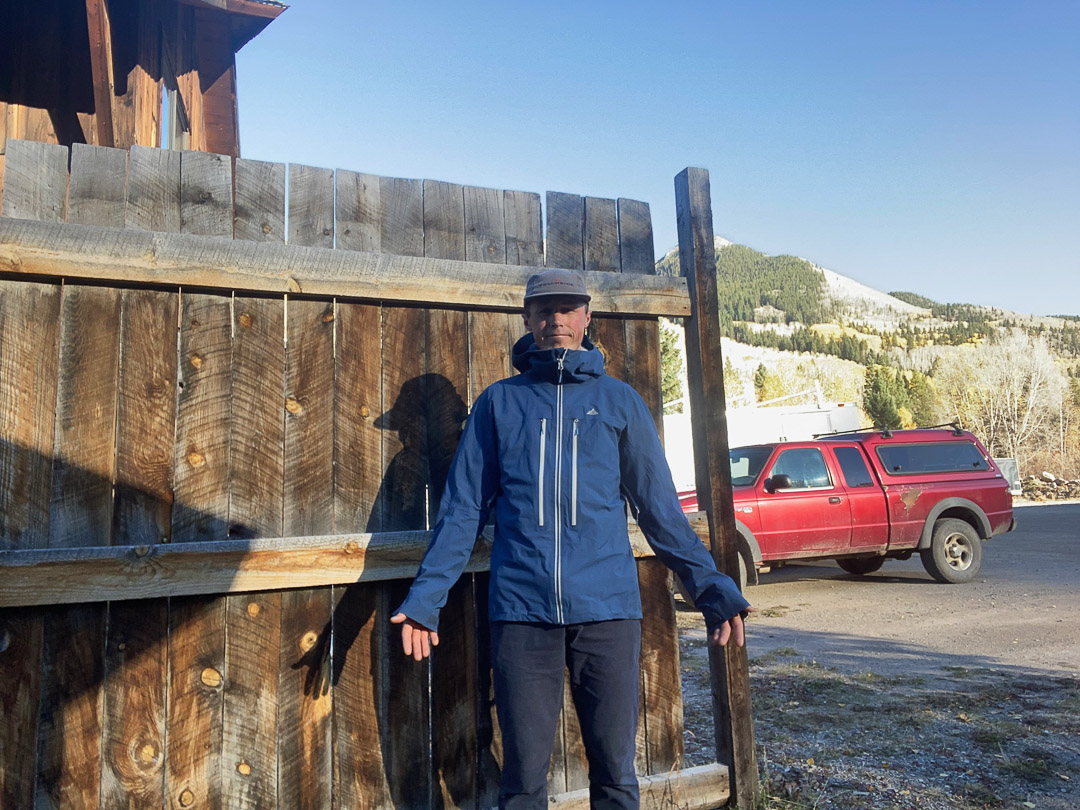
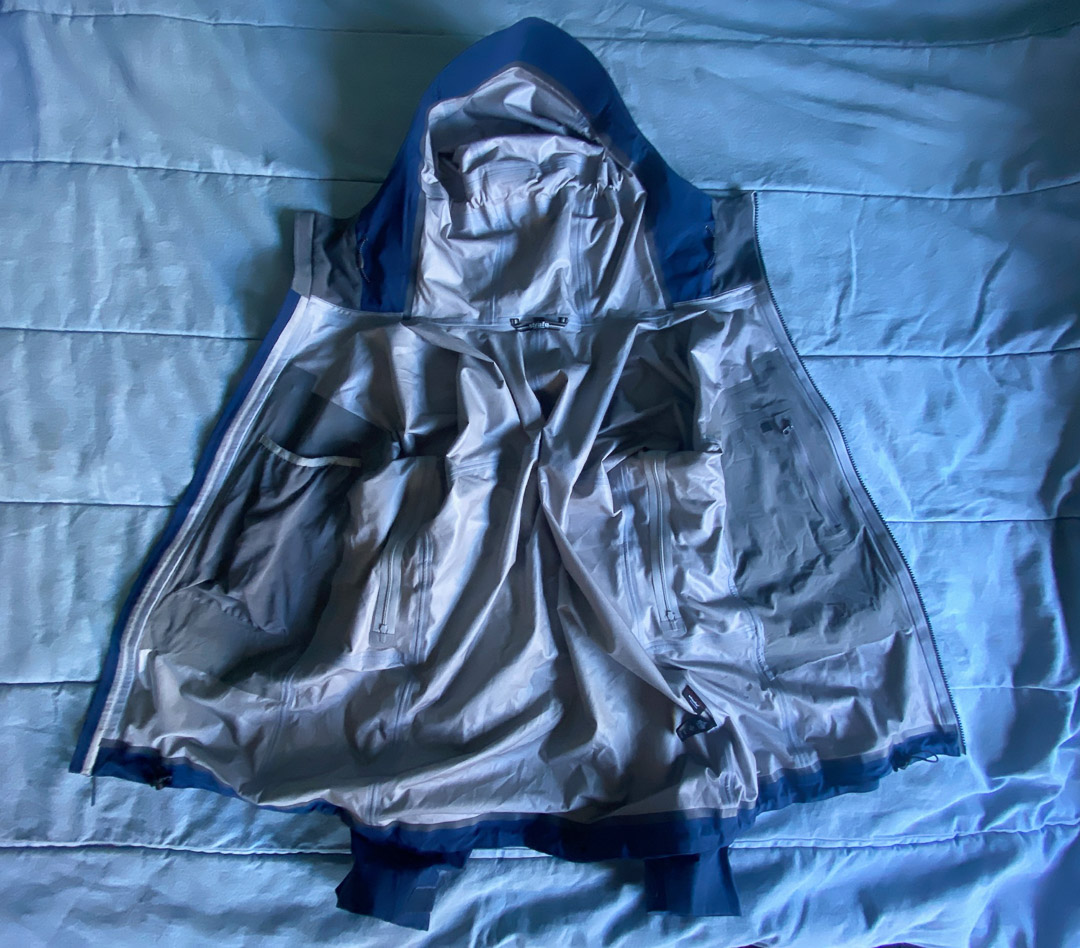
Full Zip Jacket
Slator Aplin did the testing for the Cham Jacket—here are his notes and opinions organized by likes and dislikes:
Like
North American cut: Strafe has a loose, roomy cut. If a Euro-cut implies a tighter fit, then this is a North American cut with a looser fit. I believe a tighter fit restricts one’s range of motion—both uphill and downhill—more than a looser fit for outerwear.
Best fabric for ski touring: The Schoeller Aerobrane fabric “feels” like it has a large range on the waterproof-breathable spectrum. It can stay dry on the outside (face fabric) during winter storms and stay dry on the inside when touring uphill.
Fleece at collar: When my hood is up, I want weather protection (wind and snow), and a fleece-backed fabric avoids crinkly, cold 3L fabric next to my skin.
Drawstrings at the back of the hood and lower hem: These adjustments on the jacket help “batten the hatches.” In a storm, pull the hood up, cinch the drawstrings, slide the cuffs over your gloves, and this coat feels protective in nasty weather.
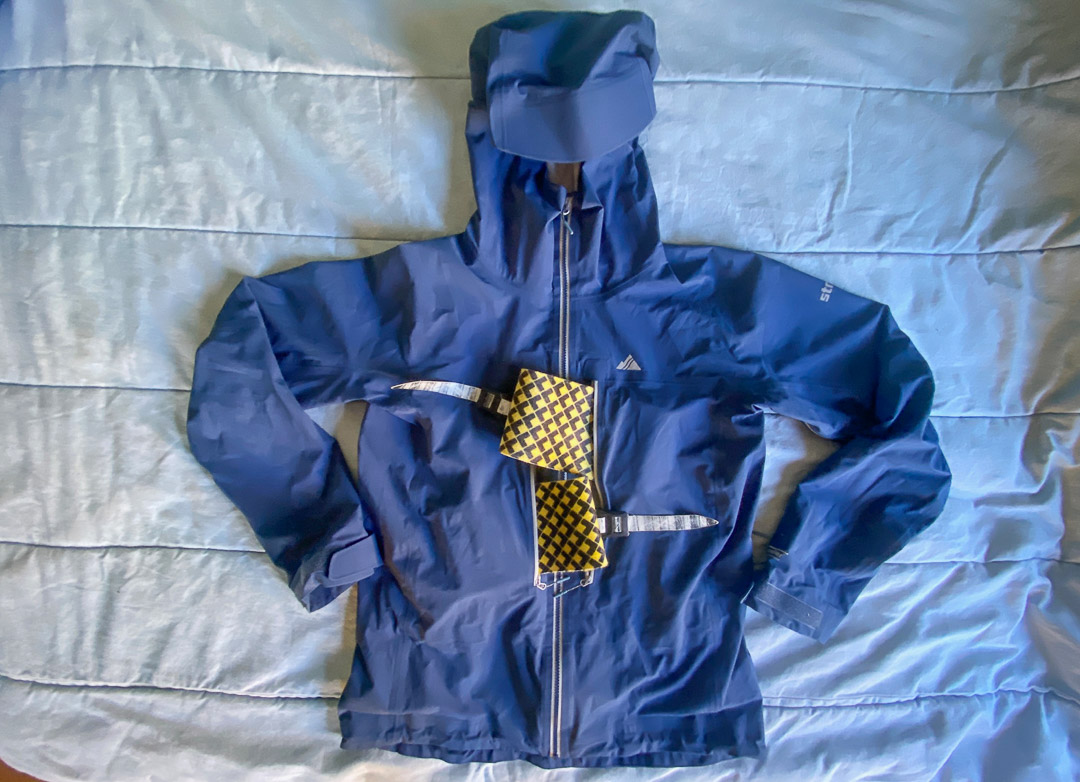
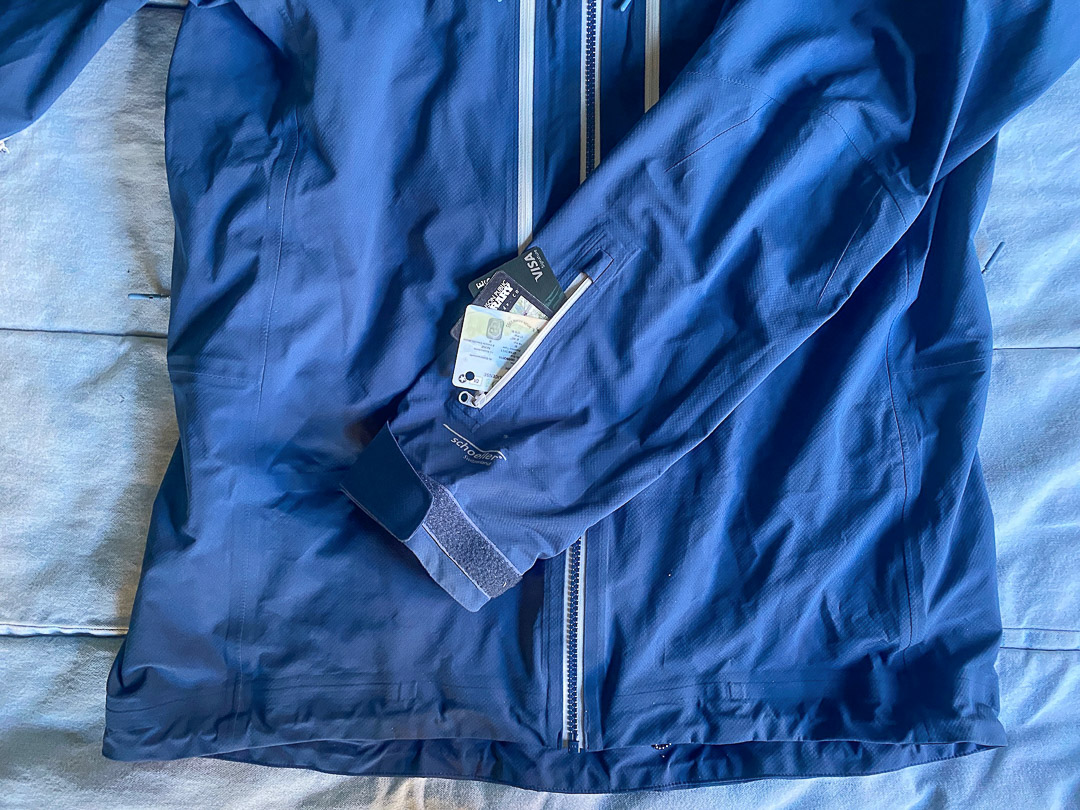
Don’t Like
Misuse of a pass pocket: I think a touring-specific ski jacket can be designed without a dedicated pass pocket on the sleeve. Consider it unnecessary and confusing for the dedicated intent of the shell.
Misuse of skins pocket: Now I’m sounding picky, but the skin pockets on the Cham feel as out of place as the pass pocket. A skins pocket on the softshell Recon jacket (also a Strafe jacket) feels appropriate because you’re most likely using that layer when touring on smaller skis with skins that are small enough to stow in a jacket pocket comfortably. An example of a great application for the Recon jacket is resort/fitness touring when you may not have a backpack and need to store skins (re: necessary skins pocket). Most backcountry touring skins that are >100 mm don’t fit comfortably in the skins pockets to enjoy skiing downhill with the skins stowed. So, in an ideal world, I’d like two mid-chest pockets—to still provide access to pockets while the pack is on—but smaller in size so I’m not fishing around for a snack or chapstick. Nonetheless, I do appreciate the internal phone holster inside the chest-level pocket.
Front hood drawstring is unnecessary: In line with the minimalist design intent of the Cham shell, the drawstrings on the front of the hood (by your face) don’t provide enough necessary cinching and adjustment to warrant their existence. IMO, the back of the hood drawstring is sufficient for cinching the hood down in both a no-helmet and helmet context.
Prefer one-way pit zips: Same as above, if the Cham intends to be a svelte backcountry shell, then one-way pit zips would be more in line with that ethos (over a two-way zipper in the same location).
Slator’s Summary
What makes the Cham jacket the best touring shell I’ve ever tried is the high-performance Schoeller Aerobrane fabric paired with a roomy, loose-fitting cut. The jacket’s design features can be more refined to reflect its minimal backcountry intent: i.e., no pass pocket, smaller chest pockets [for smaller items and not skins], and no front hood drawstrings.
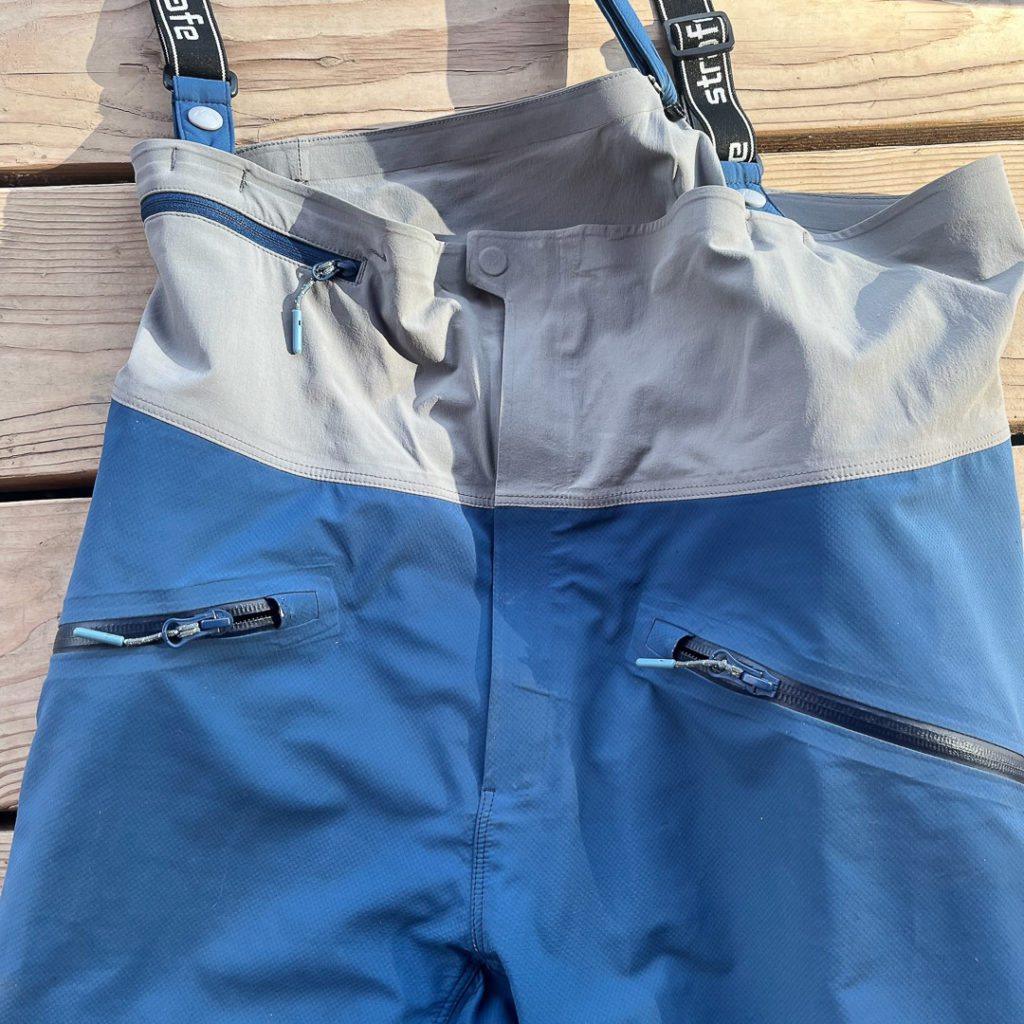
Low Bib Pants
Saving the best for last—the low bib was my favorite part of the Cham Kit and, perhaps, my favorite ski pants ever. As discussed above, the updated fit meant I sized up to a large and got an ideal fit. They are loose enough not to constrict in any context but not so loose to get caught up on crampons or feel unwieldy. Relative to more windproof pants, I definitely step up my long underwear game, often opting for the Patagonia Capilene Air bottoms on cold days.
Initially, I was a bit skeptical of the bib design, as it elicits thoughts of high-cut GoreTex bibs that seem unbearable for any sort of high-output touring. Instead, the Cham is more akin to bib shorts for cycling—they eliminate the discomfort of a waistband while being low-cut, breathable, and generally unobtrusive. Strafe makes the point that bibs are easier with a harness, which I found to hold true. As someone who has been frostbitten by a carabiner due to a harness riding up between layers in cold conditions, the overlap factor is hugely practical for managing weird layering overlaps and gaps. While I often only wear a harness for short stints in the Tetons, I appreciated the extra comfort during a trip to the Alaska Range last spring. I’m sure the same would be true in other glaciated areas where folks wear harnesses all day. Without a harness, I still enjoyed the classical benefits of bibs—mostly, no snow down my pants when I crash in powder.
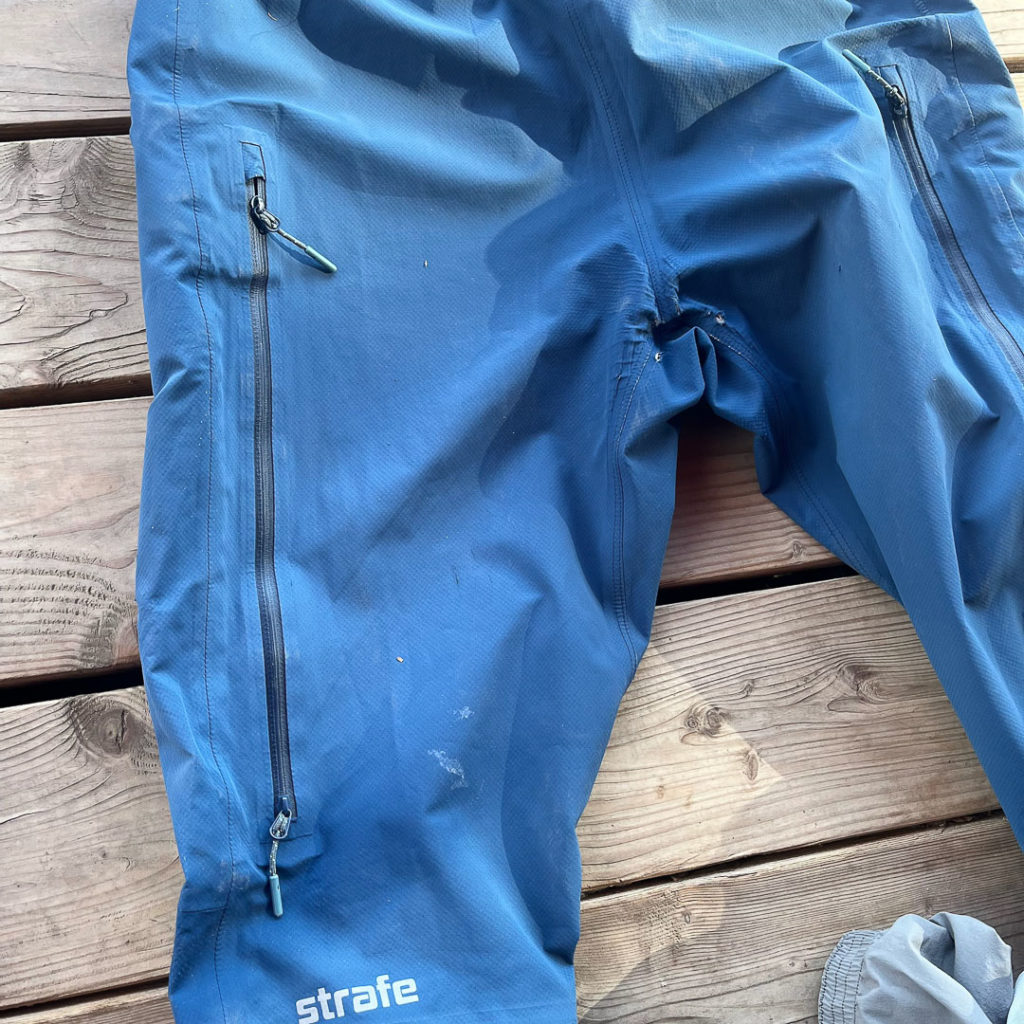
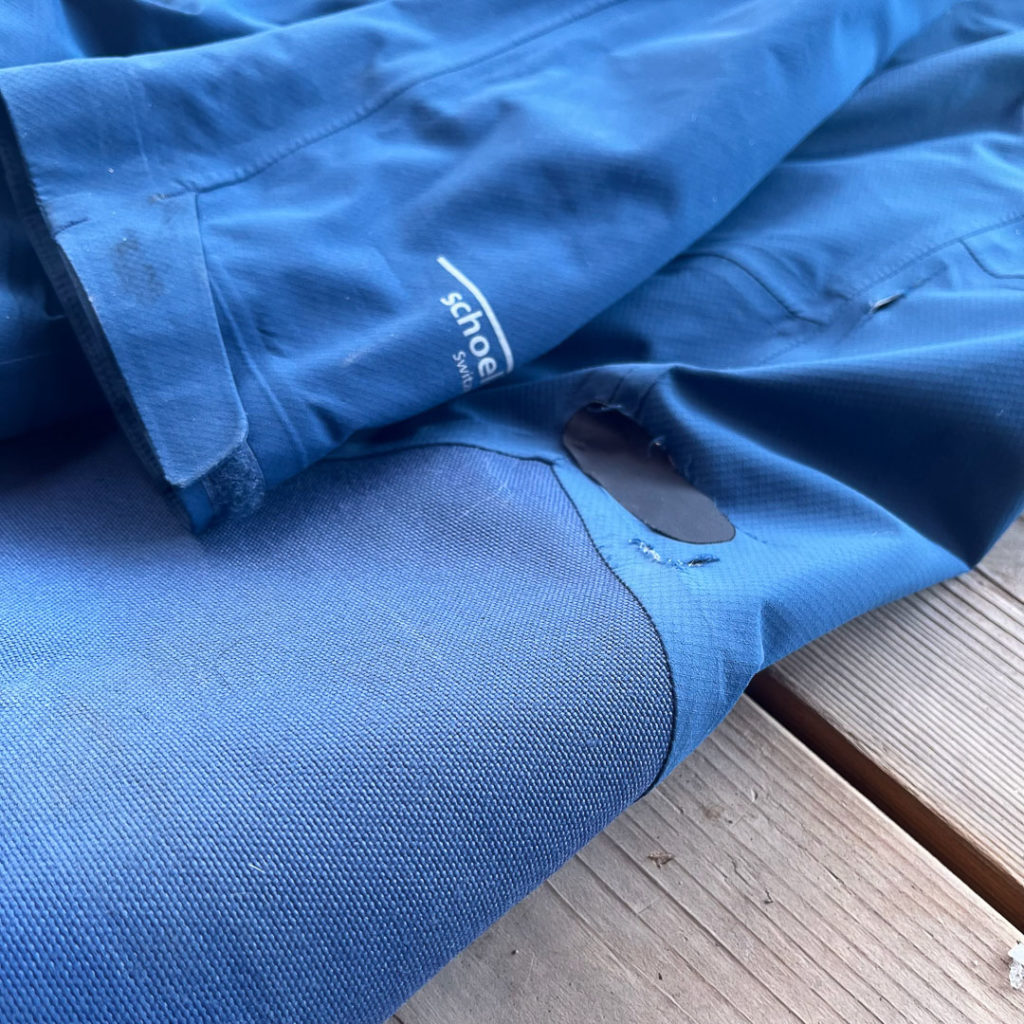
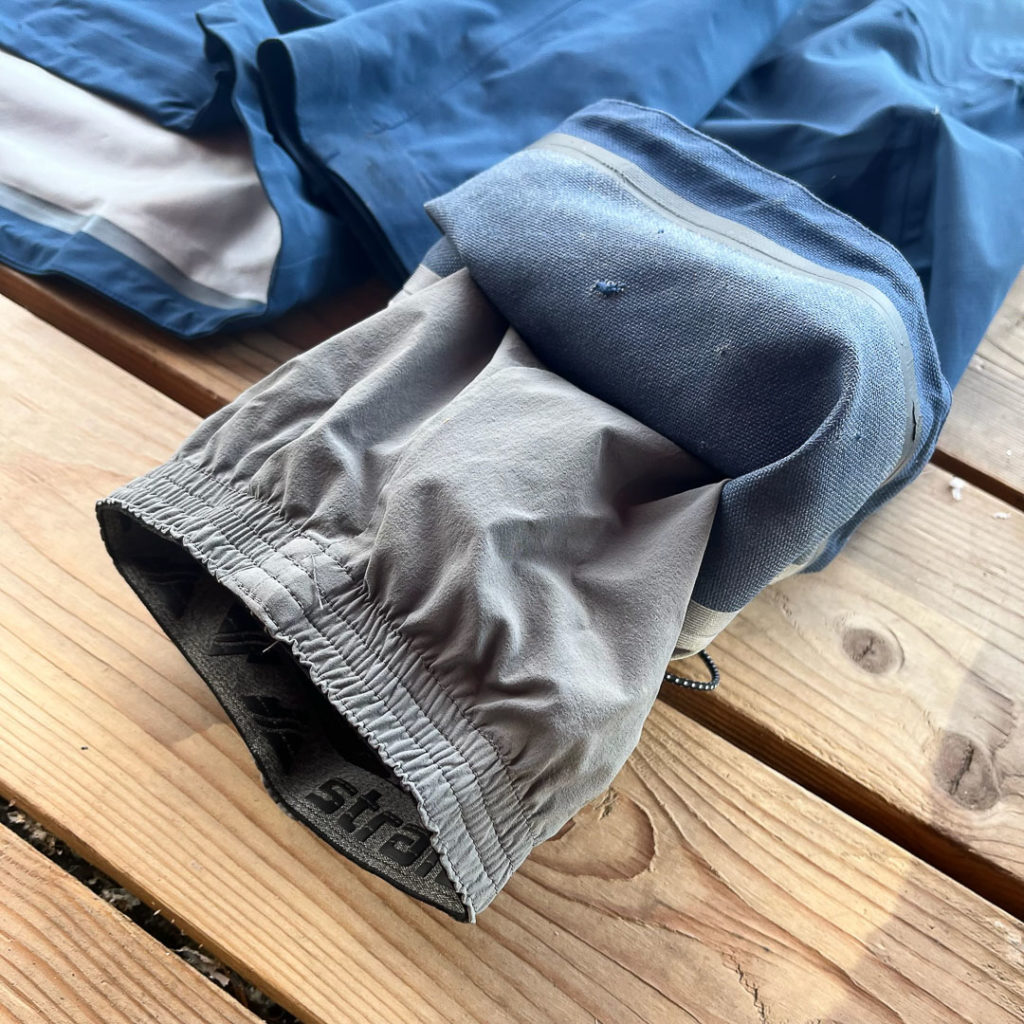
From a performance perspective, the Schoeller Aerobrane fabric continues to impress in pants form. I love the light, stretchy, and breathable feel while out touring. The Cham bibs feel amazing to walk in. The looser fit around the hips (relative to the old pants) means the hip pockets are easier to get into and feel like the right place on these pants for carrying a beacon or cell phone. The right hip pocket has an internal mesh pocket and a beacon clip-in point. A small zip pocket on the bib upper is a bit tight for my Mammut Barryvox, but it is a reasonable spot for a smaller beacon or other small odds and ends. On the pant cuffs, the instep area is reinforced but, perhaps, remains a bit small—I have a few cuts from edges/crampons above the top of the patch. As mentioned, the cuffs are simple and use a softshell gaiter that has held up well and is stretchy enough to fit with a good seal over everything from Zero G Tour Pros to my DNA Race boots.
The unfortunate downside to this wonderful pair of pants is their durability. While they held up better than the old North Face Futurelight L5 LT pants that were shredded in a few months, a (very) full season of use has left the Cham bibs thin and faded, with lots of small cuts and tears to fix. Perhaps that is the price to pay for such sweet performance, but it’s a hard pill to swallow, given the retail price of $499.
Conclusion
The world seems slow to let go of the impenetrable suit of armor that is GoreTex. The reality for many of us (Pacific Northwesterners not included) is that we live in fairly cold, dry climates and don’t need massively overbuilt waterproof clothing. After a swing toward all softshell everything, I am settling into enjoying these air-permeable, soft, and stretchy shells such as the Cham, North Face Futurelight, and Polartec Neoshell. These newer membrane technologies do an amazing job of blurring the lines between hard and soft shells and, in many cases, offer a best-of-both-worlds solution that can be a bit of a “quiver killer.” Aside from a few days in climbing pants and skimo race boots, I skied every day of last season in the Cham Pant and will likely continue to do so until they are too tattered to wear. The jackets, meanwhile, are the first shells that Slator and I would consider “all-day-wearable.”
Prices are as follows on the Strafe site:
Cham 3L Shell Jacket: $598.00
Cham 3L Shell Pullover: $429.00
Cham 3L Shel Pant (low bib): $499.00

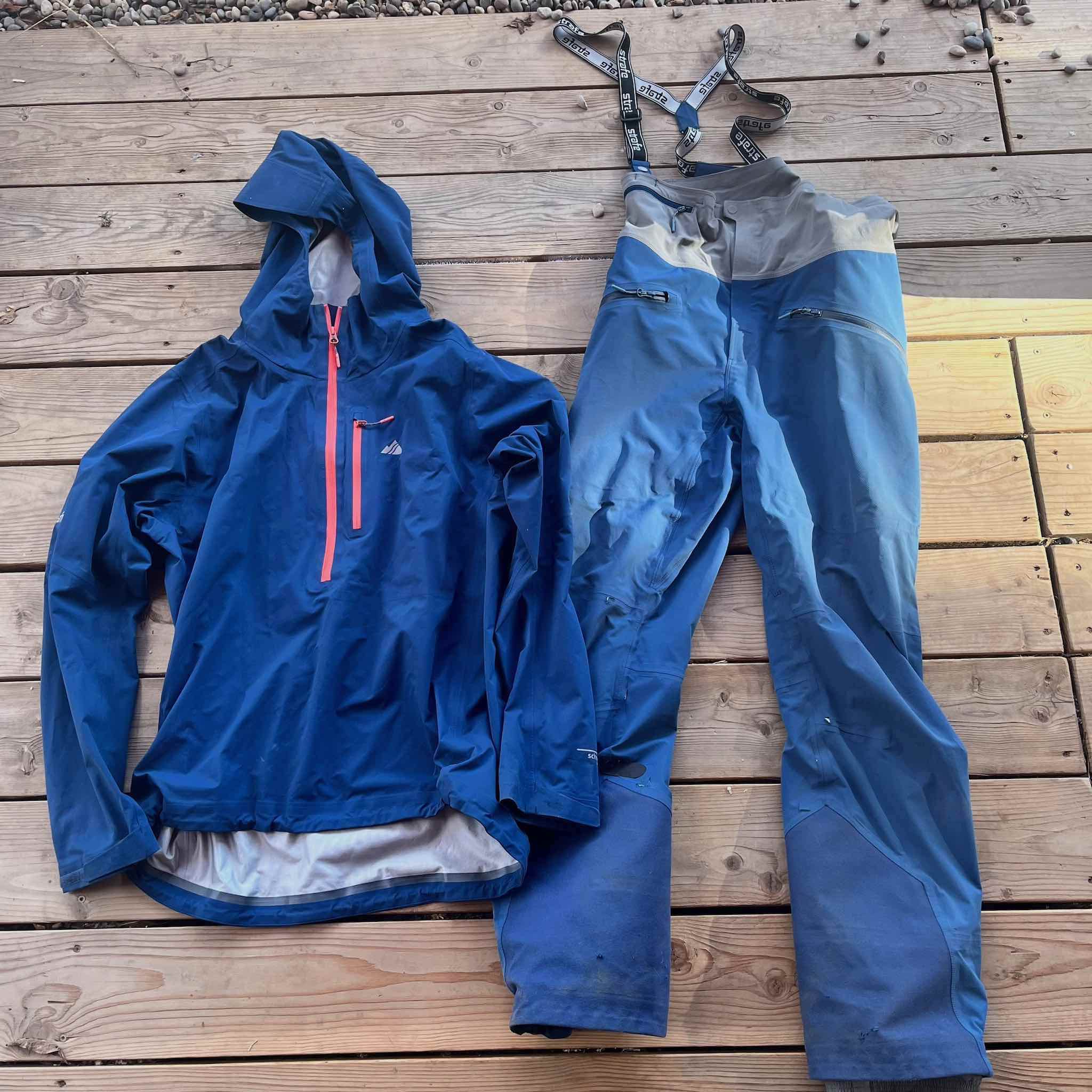




Leave a Reply
You must be logged in to post a comment.